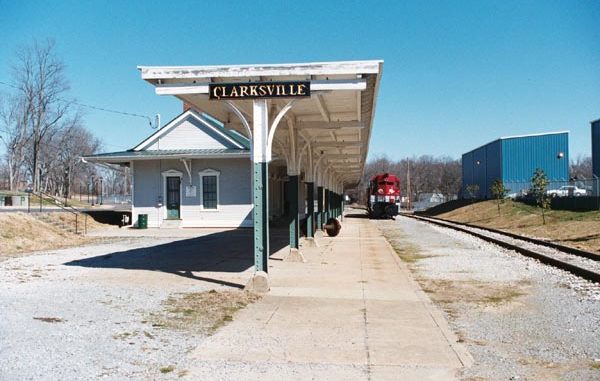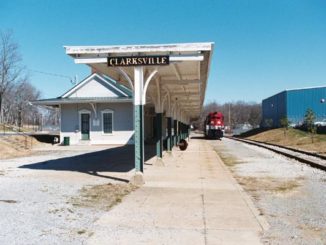
CLARKSVILLE, Tenn. — Today, it’s not much more than a bookmark in history. But, for about 20 years, the Memphis, Clarksville & Louisville Railroad operated an 82-mile stretch of track between Paris, Tenn., and Guthrie, Ky.
The Memphis, Clarksville & Louisville Railroad received it charter on Jan. 28, 1852, from the state of Tennessee. The line connected with the Memphis & Ohio Railroad and the Louisville & Nashville Railroad to provide connecting service between Memphis and Louisville.
The inaugural run on the Memphis, Clarksville & Louisville Railroad was Oct. 1, 1859, according to published notices in The Clarksville Chronicle. According to a notice published on Oct. 7, 1859, the first train featured “an Accommodation, Freight and Passenger Train.” The train ran from Clarksville to Tait’s Station, “near the junction with the Louisville and and (sic) Nashville Road, at the Kentucky State Line.”
The road connecting Memphis and Louisville wasn’t completed for that inaugural run. It wasn’t until 1861 that connecting rail service was operational. However, the Civil War would interrupt rail service on the Memphis, Clarksville & Louisville Railroad for about five years.
The Clarksville newspapers lay dormant during the Civil War, shut down by Union forces, which occupied the city for most of the conflict. There are at least three recorded raids to destroy trestles, according to archives at Middle Tennessee State University. On Feb. 2, 1862, USN Tyler destroyed track in Benton and Houston counties and a railroad bridge in Clarksville was burned. On May 21, 1862, trestle was destroyed. On Dec. 6, 1864, Lyon’s Raid on the railroad took place.
Train service resumed on the Louisville & Nashville Railroad on Aug. 13, 1866, and passenger service is believed to have started on the Memphis, Clarksville & Louisville Railroad at the same time. During the same time period, the Louisville & Nashville Railroad offered to purchase the Memphis & Ohio and the Memphis, Clarksville & Louisville railroads, both of which were on the verge of bankruptcy.
The Memphis, Clarksville & Louisville Railroad had faulted on its Tennessee Bonds in July 1866. And the following year, the Memphis & Ohio Railroad sold its assets to the Louisville & Nashville Railroad. However, the Memphis, Clarksville & Louisville Railroad held out, trying to operate self sufficiently. About a year later — on Feb. 6, 1868 — employees stopped working as the railroad was not longer able to pay their salaries.
“I regard to the whole affair as a regular conspiracy against the State authorities and the road,” then-Tennessee Gov. William G. Brownlow was quoted as saying in the Feb. 28, 1868, edition of The Clarksville Chronicle.
“I do not propose to yield to the mob spirit of any combination, monstrating to these men that the State can do as well without the advantages of the road, as the employees can without the employment, or the citizens without the active operations of the road through its disloyal territory.”
In response, the paper criticized the governor, calling him the “imp of darkness.”
Brownlow “professes to see it in a huge rebellion against the State and his imperial power and scruples not to charge said strike upon our citizens and the rebellious district through which the road runs,” the paper wrote. “The charge is grossly false and as malicious as it false. – Petty tyrants see rebellion in every manifestation of private or public virtue; it is the result conscious guilt which makes cowards of the boldest.”
After 11-days of striking, employees returned to work, as the Louisville & Nashville Railroad leased the Memphis, Clarksville & Louisville Railroad’s assets. The Louisville & Nashville Railroad saw the importance of the Memphis, Clarksville & Louisville Railroad as it was forced to reroute trains during the strike.
“Some Memphis merchants continued to fear that L&N domination would result in commercial discrimination against their city,” wrote Historian Maury Klein in his 1972 history of the Louisville & Nashville.
“Goaded mainly by public clamor over this anxiety, the Clarksville rejected every L&N overture and vowed to operate the road free of outside control. While this stance met with popular approval, it led to financial disaster. Clarksville lacked any resources to rehabilitate its line, and earnings failed to pay even operating expenses.”
But, the Memphis, Clarksville & Louisville Railroad wasn’t an easy purchase. And instead of selling the road outright to the Louisville & Nashville Railroad, the Memphis, Clarksville & Louisville Railroad sought to lease the road. That essentially extended the life of the road by about three years. But, it did not save the road.
The Memphis, Clarksville & Louisville Railroad “lacked any resources to rehabilitate its line, and earnings failed to pay even operating expenses,” Klein contends. A year earlier, in 1867, the Louisville & Nashville Railroad leased the Memphis & Ohio Railroad for a period of 10 years. Five years later, The Louisville & Nashville Railroad purchased the road outright. But taking control of the Memphis, Clarksville & Louisville Railroad and the Memphis & Ohio Railroad wasn’t an easy task for The Louisville & Nashville Railroad.
Both roads “had a backlog of unpaid salaries and supply bills, and it desperately needed funds to put the roadbed in operating condition,” Klein says. Despite the hardships, the Louisville & Nashville Railroad took control of the Memphis, Clarksville & Louisville Railroad and improved it not only financially, but helped improve its infrastructure, most importantly its track. Despite the improvements, however, the Memphis, Clarksville & Louisville Railroad would never again be able to operate self-sufficiently.
Just three years later, on Sept. 30, 1871, the Louisville & Nashville Railroad purchased the Memphis, Clarksville & Louisville Railroad outright at a value of $1,650,000. Without fanfare, the Memphis, Clarksville & Louisville Railroad disintegrated into the larger Louisville & Nashville Railroad.





